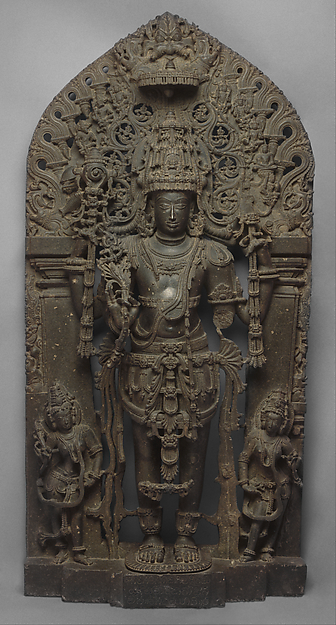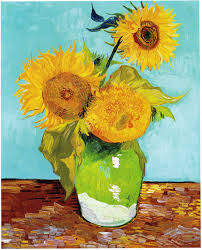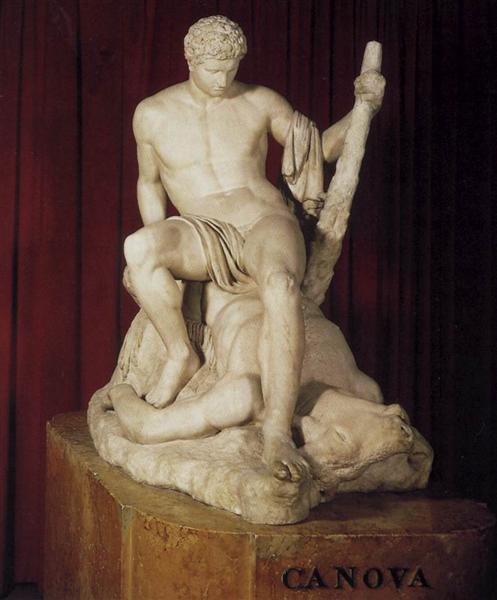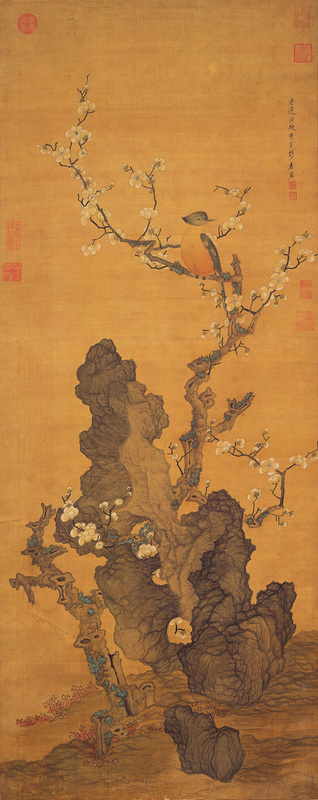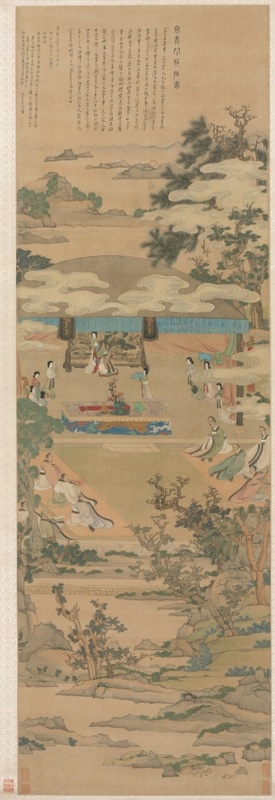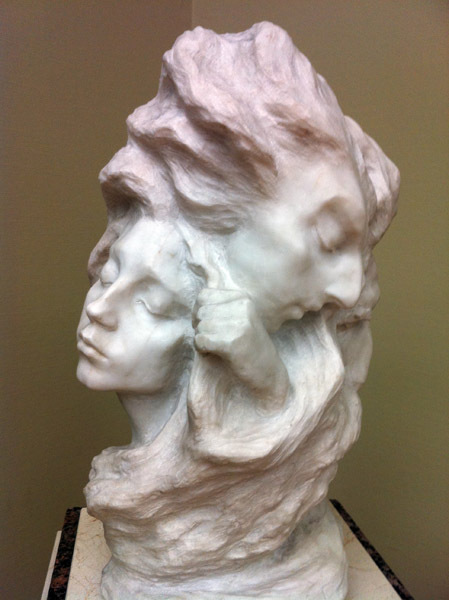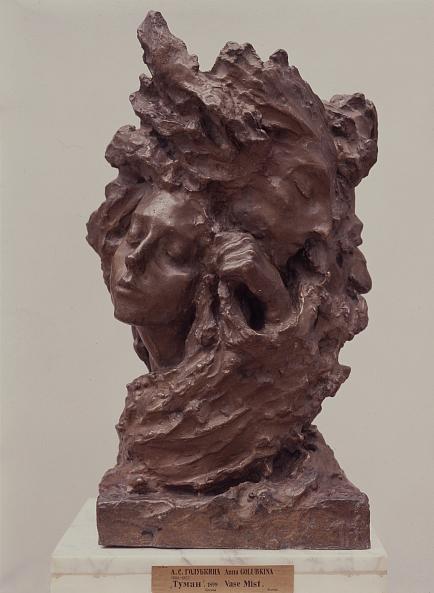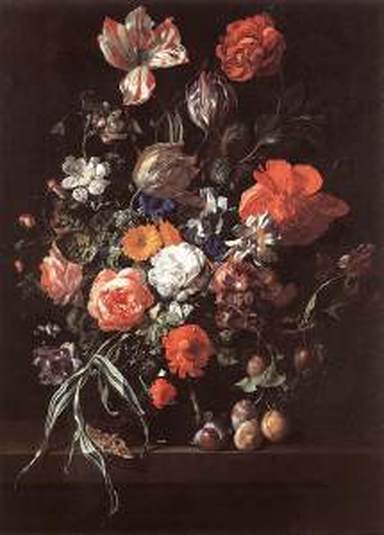Standing Vishnu as Keshav
Vincent Van Gough – Sunflowers
|
Key factsArtist :Vincent van Gogh
Artist dates:1853 - 1890 Full title: Sunflowers Date made: 1888 Medium and support: Oil on canvas Dimensions: 92.1 x 73 cm |
Rosa Bonheur – The King watches; Horse fair
Rosa Bonheur – The King watches
Antonio Canova – Theseus and the Minotaur
|
Antonio Canova (1757–1822)
Title: Theseus and the Minotaur Date: 1781-1783 Medium: marble Dimensions: (57.2 × 62.5 × 36 in) |
Ch’en Hung-shou (Chen Hongshou) – Plum Blossoms and Wild Bird
|
Chen Hongshou (陳洪綬, 1599-1652), Ming Dynasty (1368-1644)
Hanging scroll, ink and colors on silk, 124.3 x 49.6 cm, National Palace Museum, Taipei A gnarled plum tree, its angular branches covered with blossoms and buds, spirals around a large ornamental Lake Tai rock, providing a fitting perch for a wild bird. This unusual bird is perhaps more reflective of the artist's own peculiar style than that found in nature. Strong, calligraphic strokes define the trunk of the tree, and the full, rounded shapes of the blossoms were done first with delicate yet firm lines of ink and then filled with colors. The details of the blossoms were delineated with white to give them a sense of fullness and volume. The texture strokes of the rocks are also animated, making this work seem both reserved and animated. |
Xuanwen Jun Giving Instructions on the Classics
Leonardo da Vinci – Mona Lisa (La Gioconda);
|
Mona Lisa, oil painting on a poplar wood panel by the Italian painter, draftsman, sculptor, architect, and engineer Leonardo da Vinci, probably the world’s most-famous painting. It was painted sometime between 1503 and 1519, when Leonardo was living in Florence, and it now hangs in the Louvre, in Paris, where it remains an object of pilgrimage in the 21st century. The poplar panel shows evidence of warping and was stabilized in 1951 with the addition of an oak frame and in 1970 with four vertical braces. Dovetails also were added, to prevent the widening of a small crack visible near the centre of the upper edge of the painting. The sitter’s mysterious smile and her unproven identity have made the painting a source of ongoing investigation and fascination.
|
Leonardo da Vinci – Self portrait
|
This self portait was painted in 1512 using red chalk, when Leonardo da Vinci was 50 and living in France. The original painting measures 33.3 x 21.3 cm (13 1/8 x 8 3/8 in). It is now held in the magnificent collection of the Biblioteca Reale, Turin.
Leonardo da Vinci's thinking about the power of the artist can also furnish the clue to the famous enigmatic self-portrait in red chalk. It has often been remarked that on it the master looks older than his age - he can have been only about sixty when he made this drawing - and in consequence some critics have doubted whether it is a likeness of himself. Other good reasons apart, however, this portrait perfectly fits the role in which Leonardo had cast himself. A venerable old man with a long white beard, the severe eyes shaded under bushy brows, was the traditional type for representing philosophers, prophets and also God. Nobody would suggest seriously, of course, that Leonardo has drawn himself consciously in the semblance of the Almighty, but we must remember his claim that the painter contends with nature and that painting is related to God. This imposing sage who seems to have come from some other world has something of the indefinable mien of a magus, of a one who through discovering the laws of the universe knows how to manipulate them. |
Anna Golubkina –The Mist
Anna Semyonovna Golubkina (Russian: Анна Семёновна Голубкина; January 16, 1864 - September 7, 1927) was a Russian impressionist sculptor. As the first Russian sculptor to receive the Paris Salon prize, she is regarded as the first female Russian sculptor of note. Golubkina also had an exhibition at the prestigious Alexander III Museum. A crater on Venus is named after her
Rachel Ruysch – Fruit and Insects;
Rachel Ruysch, Fruit and Insects, 1711, oil on wood, 44 x 60 cm (Galleria degli Uffizi, Florence)
Rachel Ruysch –
Still-Life with Bouquet of Flowers and Plums
|
Unlike that of most 17th and 18th century female artists, Rachel Ruysch's work has never sunk into obscurity. She also enjoyed public recognition of her talent during her lifetime: in 1701, three years before painting this particularly charming bouquet, she was the first woman to be admitted to the Confrerie Pictura in The Hague, and in 1708 Johann Wilhelm, the Elector of the Palatinate, appointed her to the position of court painter. The artist's specialities were compositions with fruit, flowers and woodlands. Within this genre she was never a real innovator, but she perfectly assimilated the work of others, equalling them in terms of her painting technique. At least for certain partial aspects of flower painting she sought her own solutions, thereby imposing her own stamp on her creations. During the final decade of the 17th century we can observe the influence in particular of her teacher, Willem van Aelst, and that of Simon Pietersz. Verelst. From the beginning of the 18th century she was inspired by Jan Davidsz. de Heem and Abraham Mignon.
The use of a dark background for a bouquet is a tried and tested way of bringing colours and shapes to their own. The fact that very few flowers in the bouquet cross also shows that the painter wished to present the various species in a way that made them clearly recognisable. This almost scientific trait is certainly due, in Ruysch's case, to her father's position as a professor of botany. Typical for this period is the adding of insects and fruit of every kind, here a branch of plums. This fruit with its characteristic matt, bluish tint, which is so difficult to reproduce, appears to have been chosen by painters precisely in order to demonstrate their technical skill. One striking feature of this sumptuous bouquet is the S-shapes in the composition, with which Ruysch seeks a more natural-looking structure in contrast to the strong diagonals found in her earlier work. Rachel Ruysch's personality also speaks to our imagination: although building a professional career was something unusual for a woman at that time, she was simultaneously a "normal" woman of her time, as she bore ten children. |
